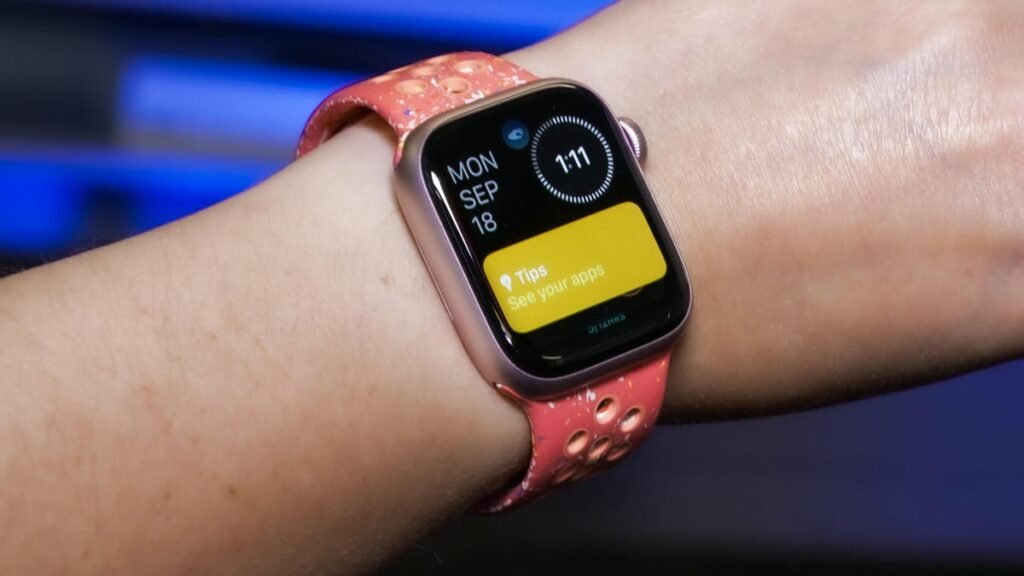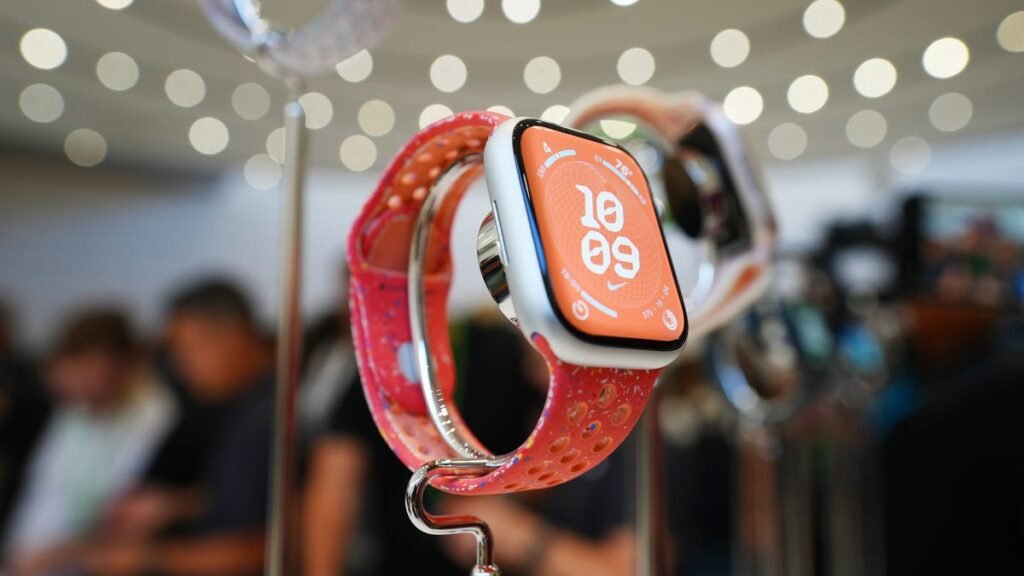The Apple Watch‘s biggest changes typically involve new health tracking capabilities, like the temperature sensor in last year’s Series 8. But something different happened in 2023. The Apple Watch Series 9‘s headlining new feature didn’t have anything to do with health at all.
Instead, Apple debuted a new way to interact with the watch through a gesture called Double Tap, which arrived on the company’s new watches through a software update on Oct. 25. Simply tap your index finger and thumb together twice, and you’ll be able to dismiss notifications, answer calls and summon your widget stack. The gesture essentially adds an invisible button to your Apple Watch.
At face value, Double Tap may not seem like a monumental change. But when you take into account other additions Apple has made in recent years, like the Apple Watch Ultra’s Action button and WatchOS 10’s widgets, it’s clear the company has been rethinking what it means to interact with the Apple Watch. The first Apple Watch went on sale more than eight years ago, and in that time, Apple has learned a lot about the difference between how a mini computer that sits on your wrist should behave compared with a larger one that fits in your pocket.
I’ve been using Double Tap since it arrived on the Series 9, and I’m starting to understand the promise behind it. The less you have to rely on touch-based interactions like tapping, typing and scrolling, the easier it should be to use the Apple Watch’s tiny screen. However, the version of Double Tap that exists today feels like a starting point. Using it for several days, and previewing it back in September when I reviewed the Series 9, left me wanting more customization options and other improvements.
A clip from Apple’s September event, showing how Double Tap works. Apple; GIF by Arielle Burton/CNET
Watch this: Apple Watch Series 9 Review: A Slightly More Convenient Watch
Double Tap isn’t meant to replace primary gestures like tapping the screen, twisting the Digital Crown or dictating Siri commands. Instead, it’s a supplement to those actions, designed for times when touching or talking to your watch may not be viable. Maybe you’re walking down the street with a cup of coffee in your hand and need to answer an incoming call. Or perhaps you’re in the middle of baking and don’t want to dismiss a timer by touching your Apple Watch with dirty hands after kneading dough.
Double Tap works only on the Apple Watch Series 9 and Apple Watch Ultra 2, because it requires the company’s new S9 chip. It processes data from sensors like the accelerometer, gyroscope and optical heart rate sensor using a machine learning algorithm to detect wrist movements and changes in blood flow, which enables it to tell when you’re tapping your index finger and thumb together.
You can use Double Tap to pull up your widgets from the home screen and dismiss notifications, but there are a handful of other uses too:
View an incoming text message and trigger a dedicated response. Answer or end a phone call. Snooze an alarm. Stop, pause or resume a timer. End or resume a stopwatch. Resume and pause music, audiobooks and podcasts. Snap a photo with your iPhone in the watch’s camera app. Start or stop automatic workout reminders. Access the Elevation view in the Compass app.
It’s easy to understand how and when Double Tap could come in handy. My problem, however, is that I haven’t found myself actually using it very often. I’ve been thinking about why Double Tap hasn’t become a big part of my daily experience with the Apple Watch, and it boils down to two answers.
The simplest, most obvious explanation is that I haven’t yet found myself in many situations that call for Double Tap. I’ve largely been working from home for the past week, meaning I haven’t fumbled with a cup of java on my way to the office or used one hand to grip the subway pole during a commute. None of that is the Apple Watch’s fault, but it underscores my point that Double Tap is meant for very specific situations.
From left: The Apple Watch Series 9 in stainless steel and in aluminum. Richard Peterson/CNET
The other is that Double Tap just doesn’t feel intuitive yet. Touchscreens have played a major role in our lives for about a decade and a half, meaning we’re conditioned to tap and swipe on screens when we feel the buzz of an incoming notification or see our screens light up. But tapping the index finger and thumb together? Not so much. It’s going to take time to build a new habit.
That said, I have been using Double Tap in some scenarios, mostly to dismiss notifications. When I’m focused on a work-related project and receive a reminder to stand up or get an Apple News alert on my wrist, Double Tapping has allowed me to swiftly cast aside these alerts without breaking my concentration. The idea that you can check a text message, come up with a response and send it without touching the watch once is also significant. This worked well in my experience and didn’t require multiple tries.
It’s moments like these that make me interested in what Double Tap means for where the Apple Watch is going. The Apple Watch feels more ambient and intuitive in this scenario, since it doesn’t require me to press a specific button to get the job done. It just knows that I want to respond to my new message and send it when I tap my digits.
But there are also ways Double Tap could become more useful. For one, it doesn’t always respond right away. I noticed this happening most often with alarms, but there have been instances when I’ve performed the gesture multiple times to summon my widgets or dismiss a notification, too. For what it’s worth, colleagues who’ve tested the Series 9 and Ultra 2 haven’t reported the same issues.
The Apple Watch Series 9. Richard Peterson/CNET
Double Tap works only when the screen is fully awake (which is not to be confused with the always-on display that shows your watch face even when your wrist is down and the screen is inactive). It’s possible I made some of my attempts when the screen was technically asleep, though perhaps this speaks to how deliberate the gesture is. However, it’s certainly better than having Double Tap be too sensitive, which could result in accidentally dismissing notifications or unintentionally answering phone calls. Even so, it can feel frustrating when Double Tap doesn’t work.
Beyond that, I wish there were more customization options available for Double Tap. You can currently choose whether Double Tap advances the widget stack or selects a widget, and you can choose between using it to play or pause music, or skip a song. These are helpful options, but I wish there were others, particularly for alarms and timers.
I frequently set 30-second timers during my pre-workout, to make sure I’m performing each stretch long enough. And to avoid injury, I typically repeat these stretches multiple times. That means I’m usually tapping the repeat button when my 30-second timer expires, rather than dismissing it. But since you can only dismiss timers with Double Tap, I can’t use the gesture when stretching. I realize this is a very specific and niche circumstance, but it’s a situation I find myself in almost every day. And since the Apple Watch is designed for workout enthusiasts, it seems like a reasonable use case.
Using Double Tap on the Apple Watch Series 9. Richard Peterson/CNET
Taken together, Double Tap, the Action button and widgets represent an effort toward making the Apple Watch more intuitive and easy to interact with. And that’s a good thing. Even though Double Tap isn’t perfect, it’s another sign that Apple isn’t just copy and pasting a shrunken-down iPhone experience.
Before Apple makes an announcement, it’s nearly impossible to know what the tech giant has in store for future products. But I have a hunch the company will be focusing on new gesture-based interactions even more in the coming years, thanks to its upcoming Vision Pro mixed reality headset.
Right now the idea of Double Tap and what it means for the Apple Watch’s direction excites me more than actually using it. But I’m looking forward to seeing how Apple refines and develops it.
Source: Read More Author:


